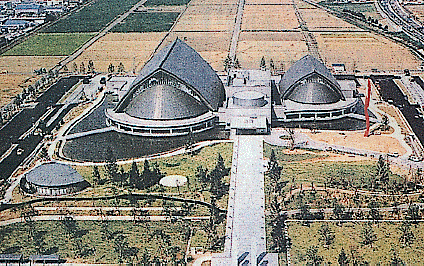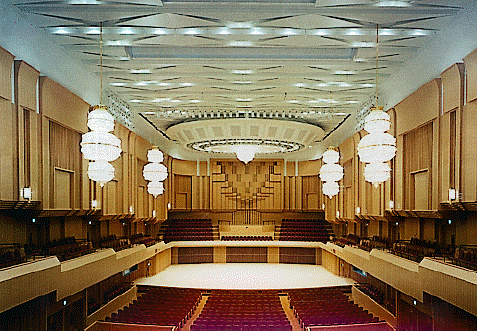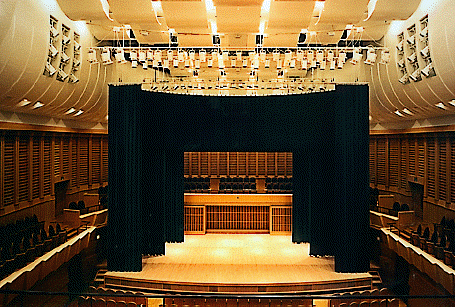
Title means "Quietness", "Comfortable Sound" and "Excellent Acoustics"
Nagata Acoustics News 97-10iNo.118j
Issued : October 25, 1997
Harmony Hall Fukui Opens
by Akira Ono
Japanese Old Style Hause
 |
Outside View of Harmony Hall Fukui
 |
Harmony Hall Fukui opened its doors to celebrate its inauguration on September 23, 1997. Construction of the hall, which was sponsored by the Fukui prefectural government, was completed on September 3, 1997. The new concert hall is located in Fukui City approximately four kilometers south of the JR railroad's Fukui Station.
Harmony Hall Fukui stands surrounded by farmland on expansive grounds of approximately 67,000 square meters. The architectural design of the facility spreads out on one level with clearly defined functional zones for the facility's large hall, small hall, and administrative offices. In the central area of the facility is the entrance space, administrative zone, rehearsal rooms and equipment/machinery space. The two halls are situated at the east and west ends of the structure. This architectural zoning afforded great advantages and savings for effective sound isolation and provided a starting point for our strategy to control ventilation system noise.
The new facility's roof design is a pattern of repeated cube-like shapes inspired by the imagery of traditional minka farmhouses of Fukui Prefecture. The Fukui minka are known for their ability to withstand the region's famous heavy winter snowfalls. Outside the facility, the park grounds are rich in trees and include a cafe as well as an outdoor stage. In this way, Harmony Hall Fukui can be a destination and gathering place for the people of Fukui when the halls are closed as well as when there are performances to attend.
<< THE LARGE HALL >>
Inside View of the Large Hall
 |
The large hall seats 1,456 persons and is a concert hall in the shoebox configuration. Seating behind the stage doubles both as seating for a chorus and for audience use. This hall has achieved a wonderfully intimate atmosphere and sense of one-ness between the performance area and the audience space. At the center of the chorus' seating a terrace has been built in to accommodate a pipe organ. (But there are no immediate plans regarding adding the organ.) Acoustically, this hall has been designed specifically for musical performances. Nevertheless, because it is safe to assume that the hall will also be used for amplified performances, we created the following arrangements. Curtains were hung from the ceiling in a "U" shape around the sides and rear of the audience seating to envelope the hall when necessary and dampen the hall's reverberation. When the curtains are not in use, the empty hall has a reverberation time of 2.2 sec / 500 Hz and when the curtains are fully extended, the reverberation time is 1.7 sec / 500 Hz. This enables adjustments of up to 0.5 seconds of reverberation time.
<< THE SMALL HALL >>
Inside View of the Small Hall
 |
The small hall seats 610 persons in an extremely intimate setting. The seating surrounds the stage, and even the height of the balcony seating is staggered to create what may be termed a "mini arena" configuration. The unique layout heightens the audience's feeling of proximity to the stage. Fundamentally, this small hall is also designed as a concert hall. However, the hall's stage is fitted with curtains to enable it to be used for performances that require the lowering of a stage curtain. The stage is equipped with a variety of curtains, including curtains that create the effect of stage wings as well curtains that drop both horizontally in the Western manner and in a straight horizontal line as used in traditional Japanese theater.
From an acoustical perspective, in addition to its stage curtains, the small hall is fitted with curtains similar to those of the large hall that can be made to descend from the ceiling to behind the audience seating, and the sides and rear of the stage are fitted with door-like panels that can be interchanged with sound-absorbing panels. For further adaptability, the front portions of the balcony's absorptive side walls are fitted with hidden panels that have a reflective finish and are designed so that they can be raised or lowered to adjust the hall's reverberation characteristic as desired. Making use of all of the adjustable equipment in this hall, the reverberation time can be varied from a minimum of 1.1 sec / 500 Hz when all of the absorptive surfaces are brought into use, to a maximum reverberation time of 1.7 sec. / 500 Hz when the curtains are all put away and the adjustable walls are all placed so that they create the greatest reflection possible. The variability is 0.6 seconds. The benefit of this design is the great versatility of the hall -- it is equally well-suited to its primary role as a venue for chamber music, as to small orchestral works, traditional Japanese music, and popular musical performances, as well as lectures, movies, and theatrical performances.
In addition to its large and small concert halls, Harmony Hall Fukui has one rehearsal room capable of accommodating an entire orchestra, as well as six other rehearsal rooms. The orchestra-sized rehearsal room is located at the side of the dressing room area for the facility's large hall. This rehearsal room is actually designed to serve both as rehearsal space and as a dressing room area, maximizing the space's versatility. In the facility's central administrative zone, six rehearsal rooms of varying size provide additional rehearsal space. Three of these rehearsal rooms include high performance soundproofing that rely on "floating" technology in their structural designs. Special soundproofing techniques were not necessary for the two concert halls or other rehearsal rooms.
<< SPEEDY CONSTRUCTION AND A RUSHED OPENING >>
Typically, the preparation period to fine-tune a facility such as Harmony Hall Fukui requires at least three months. But at Harmony Hall Fukui everything was forced to take place in record time. After the start of construction was delayed three months in connection with prefectural government matters, the hall was built in just 20 months. This was accomplished despite the weather having lived up to Fukui's reputation of heavy winter snows and high rainfall. Then the opening events were planned and implemented in less than a month's time, putting the hall's staff under huge pressure as the facility staged its opening with almost no preparation time at all.
As soon as construction was completed, Maestro Hiroyuki Iwaki began rehearsals with the local amateur orchestra chosen to play the facility's opening night performance. He also immediately began to make several requests of the brand-new (and untested) hall. Maestro Iwaki has been closely associated with the hall since its inception. He was one of the hall's design competition judges, and he participated as an advisor throughout the design and construction phases. Throughout, Maestro Iwaki voiced his concern about the lack of preparation time that was being allotted between the completion of construction and the official opening of the facility. Several other halls also have their opening in Japan this autumn, and each of these other halls included testing and preparation time between the completion of construction and their official openings. As a result of scheduling preparation time after the completion of construction, these other halls, including Opera City Concert Hall and Sumida Triphony Hall, both in Tokyo, benefited from test performances by professional orchestras. Maestro Iwaki understandably lamented the lack of adequate timing for test performances and fine-tuning preparation of Harmony Hall Fukui after construction was completed. His concern was especially strong because the orchestra he was conducting on opening night is an amateur ensemble. It was very risky to ask them to crown the opening of the hall with a performance when there had been so little time for rehearsal and no chance to get used to the sound of the large space of the new hall. Unfortunately, Maestro Iwaki did not prevail in lengthening the preparation period.
It is well worth asking why Harmony Hall Fukui decided to accept the heavy risk implicit in opening the hall to the public without an adequate preparation period. There have been numerous government-built halls that were pushed into rushed openings so that the public would enjoy them immediately before an election, but this time there was no such election "waiting in the wings." Furthermore, while Harmony Hall Fukui will be the venue for a performance by the Vienna Philharmonic on October 16, 1997, this is the only significant performance planned by the hall in addition to Maestro Iwaki's official opening of the hall. Certainly, by having Harmony Hall Fukui mentioned in all of the Vienna Philharmonic's Japan-tour advertisements, the hall is creating a perfect opportunity to become well-known throughout Japan -- if not overseas as well. But this is all that the administrators of Harmony Hall Fukui have done to breathe life into their new facility. Risking too soon an opening and planning for just one important concert do not make for a vibrant cultural venue. While it is important to invite famous names from around the globe, the hall should not be silent when these visitors are gone. Nor should the hall wait for the local population to come forward to rent the hall for their events.
Harmony Hall Fukui should pro-actively develop programs and activities that will attract audiences to the hall and stimulate their affection for it. The facility has begun promoting friends-of-the-hall memberships -- "Harmony Mates" -- to stimulate local interest, and there is talk about truly making this a facility in which the all of the people of Fukui Prefecture can become involved. These are starts. I certainly hope that they indicate that the facility's administrators will grow passionate about planning programs for the hall and that local programs will flourish, making full use of the many possibilities this new hall offers.
For more information about Harmony Hall Fukui, please call the hall directly at 81-776-38-8288.
Acoustical Design in Multipurpose Buildings -- My Experience with Japanese "Station Buildings"
by Suzuyo Yokose
During the past year, much of my design work has been on halls that are part of the ubiquitous shopping/dining/entertainment complexes at train stations. Known in Japanese as eki-mae-biru ("buildings in front of stations"), these complexes may be attached to a train or subway station, adjacent to the station, or in close proximity to it. Because of the importance of rail transportation in Japan, these complexes stand on extremely valuable real estate. High volumes of foot traffic pass in and around them.
Certainly. one acoustician's client list does not provide a scientific sample from which we can determine if there is a new trend to locate halls in station buildings. However, because I have recently worked repeatedly on multipurpose building projects, I do have some general thoughts on commonalties in this kind of work that I would now like to share.
<< HALLS IN MULTIPURPOSE STATION BUILDINGS >>
The most common division of space in multipurpose station buildings is retail and office commercial space on the lower floors and the hall and other public space on the upper levels. By creating a facility that will draw large numbers of people to the top of the building, owners and others involved with the building's operation hope to ensure increased and sustained foot traffic to the commercial space on the lower floors as well. From an acoustics perspective it is also preferable to put the building's hall at the top of the building so that it is as far away as possible from the effects of the noise and vibration of the railroad or subway tracks and the automotive and other traffic on the streets near the building. However, the top floors of these buildings require light-weight structural designs and this is a hindrance in designing the room sound isolation for these halls. In my experience, these buildings rely heavily on the use of dry construction methods. In this kind of structural environment, not only is it important to ensure that sound does not leak into the hall from outside, but it is equally essential that sound does not leak from the hall and rehearsal rooms to spaces in the facility dedicated to other purposes. Multipurpose buildings house many proprietors who must exist side-by-side. I have experienced situations where some of the occupants of a multipurpose building were unwilling to make accommodations or try to understand the acoustical requirements of the building's public hall.
<< PUBLICLY-FUNDED FACILITIES >>
Most of Nagata Acoustics' collaborations on multipurpose buildings have been in the context of publicly-funded facilities. These facilities include conference rooms, music rehearsal rooms and a variety of seminar/classrooms and workshops for cooking classes, crafts production, and audio visual arts. These days, each project also invariably includes a multipurpose hall. From an acoustician's perspective, the first place to begin work on a hall in this kind of environment is to consider how we will insulate the space inside the hall from outside noise.
<< SOUND ISOLATION >>
As I mentioned above, many of my recent projects made heavy use of dry construction methods. While all of the dry board manufacturers offer products developed to provide high performance sound isolation, a myriad of problems arises when using any of these products in actual construction. How should one deal with the spaces created at joints and how should these products be used in conjunction with the fireproofing of the steel framework? The answers to these and other questions do not appear on the architectural design drawings, but come to light only when actual construction is under way. As a result, during the construction of each multipurpose building, I was required to participate in frequent and detailed on-site consultations. This significantly increased my workload during the construction stage of each project and created the need for considerable cooperation and collaboration with each project's general contractor.
Before addressing the technical challenges of sound isolation, I discovered another unique characteristic of these kinds of facilities that needed to be considered. This is the question of just how quiet each room needs to be. Unlike a facility in which a large hall is the main attraction, in a multipurpose facility there are often competing opinions as to which room of the facility is "the star of the show." Local groups and clubs endure long waits before the realization of these conveniently located buildings with classrooms and rehearsal rooms at last come to fruition. In the suburbs surrounding urban areas, demand can be so high for these facilities that they often book their entire first several months of operation on the first day they begin taking reservations. For the individuals who wish to study cooking, their part of the facility is of course the most important, while the dance studio will be first in importance for people who plan to take aerobics lessons, and so for each room and activity planned.
As I studied floor plan for each project, I was often hard pressed to judge exactly what level of sound isolation was essential to each room. The sponsors of some multipurpose facilities provided me with clear direction on their expectations and intended uses of each part of the facility. Often, however, what activities would be assigned to which rooms was still undecided at the time I needed to make my decisions on soundproofing and sound isolation. In practice, it was I, the acoustician, who frequently the decided the parameters of usage for the rooms, the expectations of sound levels that would be produced thereby, and the acceptable soundproofing and isolation settings. In some cases, I would convey this information directly to the client. In other cases, I would communicate with the general contractor who would obtain the understanding of the client.
<< MULTIPURPOSE HALLS >>
The halls I recently designed in connection with the publicly-funded multipurpose facilities are small scale halls seating 200 - 500 persons. In initial meetings with the client, they invariably expressed only vague ideas about the content of performances and events to be held in the hall. A typical request would be for a hall that would accommodate amateur music recitals and dramatic performances as well as lectures, but that could also serve as a venue for occasional performances by professional musicians. As a result of the exceedingly broad content to which each of these halls needs to adapt, they all follow the same pattern of having movable seating and interchangeable stage curtain and suspended reflectors to accommodate both theatrical and music performances.
I employed two systems of movable seating depending on the sound isolation requirements. In one seating system, the seats are stored in a storage room. In the other seating system, the seating is part of a floor unit which can be raised or lowered out of sight as needed. When a hall's flooring includes measures to reduce vibration, problems arise in using the first seating system. This is because the weight impacting on the floor varies greatly depending on whether the seating is deployed or whether it is stored away, and this variable factor makes it difficult to select the appropriate vibration-absorbing material. Unless the weight of the floor can be determined (and the variability of the impacting weight limited), a vibration absorption material that has the right amount of pliability when the seats are deployed will have no pliability when the seats are not there to weigh down on it, and, therefore, it will not absorb vibrations as desired (Natural frequency will increase.) Furthermore, as I mentioned earlier, from a construction perspective lighter-weight flooring is desirable, while from our acoustical perspective, heavier is better. In these projects, the general contractor was thus constantly in the position of having to make choices between mutually exclusive options and their resulting benefits.
<< IN CONCLUSION >>
In multipurpose buildings, the vast majority of work time was spent on soundproofing and sound isolation strategies. Unlike our wealth of experience with poured concrete structures, our experience with high performance soundproofing and sound isolation for lighter building methods, such as the dry method, is still not well-advanced. Academically, I already knew that in this kind of construction project the primary challenge is planning to reduce the crevices through which sound can leak. Yet when I first had the opportunity to visit one of these projects' construction site, I was still stunned to see wall after wall with crevices allowing even slivers of light to pass through to the other side. These were, of course, walls that I had been counting on to include as a layer of sound isolation, and I had to quickly devise strategies to overcome these walls' obvious deficiencies as sound barriers. Nevertheless, I was able to design adjustments in a timely manner, avoiding the usual construction industry precedents in which the value of acoustics was not considered until a structure was completely built and only expensive corrective measures remained available. Thankfully, in my projects, the importance of acoustics was given its appropriate recognition. I was able to make my voice heard and see many of my ideas and requests implemented at all stages of the buildings' development. With the proactive cooperation of the general contractors, and the incorporation of my acoustical expertise, each multipurpose facility achieved the sound isolation performance levels I forecasted.
These long-desired, long-awaited "station buildings" are built in local communities and open to all in each community who care to use them. I hope they will serve each community well.
Nagata Acoustics News 97-10iNo.118j
Issued : October 25, 1997
Nagata Acoustics Inc.
E-mail: info@nagata.co.jp






